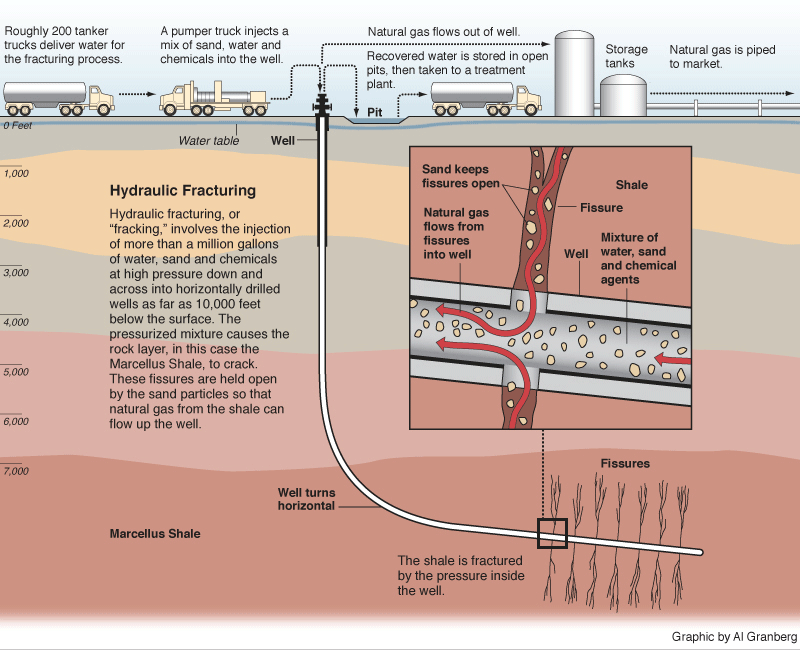George Osborne, the Chancellor of the Exchequer of the UK, just announces "Gas Generation Strategy" on 5th December. This plan will partly provide tax incentives for shale gas production companies, which critics believe will lock Britain in to a high-carbon future, according to the Guardian. [1]
Shale gas by definition is nature gas trapped in shale rocks. Nature gas, although is cleaner than coal (less pollutant after burning), the drilling process of shale gas has been a highly controversial issue.
Shale formations, source: U.S. Energy Information Administration
Shale gas used to be uneconomical to produce, while during last decade the U.S. have invented a method, hydraulic fracturing aka fracking, to drill shale gas out in a commercial scale. Since 2005 shale gas production in the states has been booming; now it accounts for one third of the total nature gas production. And shale gas surge has not only led to a drop in gas price for households, but also a switch to cheap gas from coal in power plants. The latter did have a influence on the nation's CO2 emission, which in 2010 were lower than in 2005 by 7 percent. [2] Many countries including China and UK, now want to explore its own shale gas reservoirs to "not miss out on the opportunities being enjoyed in the U.S"[1].
At first glance, shale gas seems to be a good alternatives to fossil fuels. However, shale gas has two accompanying potential problems. One is the nature of gas, methane is a powerful greenhouse gas having 25 times global warming potential than CO2. We'll come to this point later. The other danger is coming from the hydraulic fracturing process.
To mine out shale gas, first, a hole is drilled down to the shale layer, which is hundreds of meters wide but only ten meters thick, so the wellhole is turned horizontally. Then a mix of vast amounts of water, sand and chemicals is injected under high pressure into the well, creating tiny fissures in the shale rocks, through which the natural gas flows into well.
Fracking process, source: http://www.propublica.org
So why is fracking so controversial?
Water contamination is one of major hazardous problems. When shale layer is beaneth aquifers, if mismanaged, the water-chemical mixture ― which may contain toxic chemicals (benzene, lead etc.) ― and methane as well can be released into the aquifer by leaks and faulty wells [3]. According to ProPublica, "water contamination has been reported in more than a thousand places where drilling is happening" [4]. In addition, fracking process is related to some small-scale earthquakes and seismic activity. Moreover, Howarth et al. indicate that the emissions of shale gas are greater than conventional gas, coal or oil over a short term time scale (20 years) [5]. On the other hand, other studies suggest that greenhouse gas footprint of shale gas is lower than coal; higher than conventional gas [6]. And a recent report for European Commission proposes that if emissions from shale gas are not controlled, the greenhouses gas emissions from domestic shale gas will be greater than utilizing imported conventional gas [7].
In summation, keeping on investment in shale gas may undermine developments in renewable energy. With these potential costs to the environments and contaminants to drinking water, the U.S. EPA is currently carrying out a study of the fracking, while New York state has bloked fracking. Meanwhile, in Europe, France and Bulgaria have banned shale gas fracking. It seems like the U.K. may be a little bit 'avant-garde' in exploiting shale gas.
References
1. Gas strategy unveiled by George Osborne, the Guardian, 2012.
2. Good gas, bad gas, National geographic report, 2012.
3. What is shale gas and why is it important?U.S. Energy Information Administration, 2012.
4. Gas Drilling: The Story So Far, ProPublica, 2010.
5. Methane and the greenhouse-gas footprint of natural gas from shale formations, Howarth et al, Climate change, 2011. DOI 10.1007/s10584-011-0061-5
6. A commentary on “The greenhouse-gas footprint of natural gas in shale formations” by R.W. Howarth, R. Santoro, and Anthony Ingraffea, M. Cathles et al., Climatic Change, 2012. DOI 10.1007/s10584-011-0333-0
7. Climate impact of potential shale gas production in the EU, EC DG Climate Action, 2012.


No comments:
Post a Comment